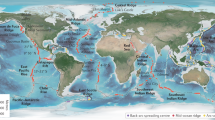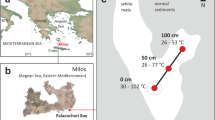Abstract
Hydrothermal vents along mid-ocean systems host unique, highly productive biological communities, based on microbial chemoautotrophy, that thrive on the sulphur, metals, nitrogen and carbon emitted from the vents into the deep ocean. Geochemical studies of vents have centred on analyses of high-temperature, focused hydrothermal vents, which exhibit very high flow rates and are generally considered too hot for microbial life. Geochemical fluxes and metabolic activity associated with habitable, lower temperature diffuse fluids remain poorly constrained. As a result, little is known about the extent to which microbial communities, particularly in the subsurface, influence geochemical flux from more diffuse flows. Here, we estimate the net flux of methane, carbon dioxide and hydrogen from diffuse and focused hydrothermal vents along the Juan de Fuca ridge, using an in situ mass spectrometer and flowmeter. We show that geochemical flux from diffuse vents can equal or exceed that emanating from hot, focused vents. Notably, hydrogen concentrations in fluids emerging from diffuse vents are 50% to 80% lower than predicted. We attribute the loss of hydrogen in diffuse vent fluids to microbial consumption in the subsurface, and suggest that subsurface microbial communities can significantly influence hydrothermal geochemical fluxes to the deep ocean.
This is a preview of subscription content, access via your institution
Access options
Subscribe to this journal
Receive 12 print issues and online access
$259.00 per year
only $21.58 per issue
Buy this article
- Purchase on Springer Link
- Instant access to full article PDF
Prices may be subject to local taxes which are calculated during checkout


Similar content being viewed by others
References
Fisher, C. R. Jr, Takai, K. & Le Bris, N. Hydrothermal vent ecosystems. Oceanography 20, 18–27 (2007).
Johnson, H. P. & Pruis, M. J. Fluxes of fluid and heat from the oceanic crustal reservoir. Earth Planet. Sci. Lett. 216, 565–574 (2003).
Mottl, M. J. in Energy and Mass Transfer in Marine Hydrothermal Systems (eds Halbach, P., Tunnicliffe, V. & Hein, J.) 271–286 (Dahlem Univ. Press, 2003).
Wheat, C. G., McManus, J., Mottl, M. J. & Giambalvo, E. Oceanic phosphorus imbalance: Magnitude of the mid-ocean ridge flank hydrothermal sink. Geophys. Res. Lett. 30, 1895–1899 (2003).
Lilley, M. D., Butterfield, D. A., Lupton, J. E. & Olson, E. J. Magmatic events can produce rapid changes in hydrothermal vent chemistry. Nature 422, 878–881 (2003).
Lilley, M. D. et al. Anomalous CH4 and NH4+ concentrations at an unsedimented mid-ocean-ridge hydrothermal system. Nature 364, 45–47 (1993).
Tivey, M. K. Generation of seafloor hydrothermal vent fluids and associated mineral deposits. Oceanography 20, 50–65 (2007).
Tivey, M. K., Humphris, S. E., Thompson, G., Hannington, M. D. & Rona, P. A. Deducing patterns of fluid flow and mixing within the TAG active hydrothermal mound using mineralogical and geochemical data. J. Geophys. Res. 100, 12527–12555 (1995).
Von Damm, K. L. & Lilley, M. D. in The Subfloor Biosphere at Mid-Ocean Ridges (eds Wilcock, W. S. D., DeLong, E. F., Kelley, D. S., Baross, J. A. & Cary, S. C.) 245–268 (American Geophysical Union, 2004).
Von Damm, K. L. et al. Evolution of East Pacific Rise hydrothermal vent fluids following a volcanic eruption. Nature 375, 47–50 (1995).
Wheat, C. G. et al. Heat and fluid flow through a basaltic outcrop on a ridge flank. Geochem. Geophys. Geosyst. 5, Q12006 (2004).
Hutnak, M. et al. Large heat and fluid fluxes driven through mid-plate outcrops on ocean crust. Nature Geosci. 1, 611–614 (2008).
Fisher, A. T. et al. Hydrothermal Vent recharge and discharge across 50 km guided by seamounts on a young ridge flank. Nature 421, 618–621 (2003).
Huber, J. A., Butterfield, D. A. & Baross, J. A. Temporal changes in archaeal diversity and chemistry in a mid-ocean ridge subseafloor habitat. Appl. Environ. Microbiol. 68, 1585–1594 (2002).
Chapelle, F. H. et al. A hydrogen-based subsurface microbial community dominated by methanogens. Nature 415, 312–315 (2002).
Summit, M. & Baross, J. A. A novel microbial habitat in the mid-ocean ridge subseafloor. Proc. Natl Acad. Sci. USA 98, 2158–2163 (2001).
Sogin, M. L. et al. Microbial diversity in the deep sea and the underexplored ‘rare biosphere’. Proc. Natl Acad. Sci. USA 103, 12115–12120 (2006).
Huber, J. A., Butterfield, D. A., Johnson, H. P. & Baross, J. A. Microbial life in ridge flank crustal fluids. Environ. Microbiol. 8, 88–99 (2006).
Edwards, K. J., Bach, W. & McCollom, T. M. Geomicrobiology in oceanography: Microbe-mineral interactions at and below the seafloor. Trends Microbiol. 13, 449–456 (2005).
Butterfield, D. A. et al. Gradients in the composition of hydrothermal fluids from the Endeavor segment vent field: Phase separation and brine loss. J. Geophys. Res. 99, 9561–9583 (1994).
Elderfield, H. & Schultz, A. Mid-ocean ridge hydrothermal fluxes and the chemical composition of the ocean. Annu. Rev. Earth Planet. Sci. 24, 191–224 (1996).
Schultz, A., Delaney, J. R. & McDuff, R. E. On the partitioning of heat flux between diffuse and point source seafloor venting. J. Geophys. Res. 97, 12299–12315 (1992).
Butterfield, D. A. et al. in The Subseafloor Biosphere at Mid-Ocean Ridges (eds Wilcock, W.S.D., DeLong, E.F., Kelley, D.S., Baross, J.A. & Cary, S.C.) 269–289 (American Geophysical Union, 2004).
Johnson, K. S., Beehler, C. L., Sakamoto-Arnold, C. M. & Childress, J. J. In situ measurements of chemical distributions in a deep-sea hydrothermal vent field. Science 213, 1139–1141 (1986).
Le Bris, N., Govenar, B., Le Gall, C. & Fisher, C. R. Jr Variability of physico-chemical conditions in 9 °50′ N EPR diffuse flow vent habitats. Mar. Chem. 98, 167–182 (2006).
Proskurowski, G., Lilley, M. D. & Olson, E. J. Stable isotopic evidence in support of active microbial methane cycling in low-temperature diffuse flow vents at 9 °50′ N East Pacific Rise. Geochim. Cosmochim. Acta 72, 2005–2023 (2008).
Walker, B. D., McCarthy, M. D., Fisher, A. T. & Guilderson, T. P. Dissolved inorganic carbon isotopic composition of low-temperature axial and ridge-flank hydrothermal fluids of the Juan de Fuca Ridge. Mar. Chem. 108, 123–136 (2008).
Ding, K. et al. The in situ pH of hydrothermal fluids at mid-ocean ridges. Earth Planet. Sci. Lett. 237, 167–174 (2005).
Seewald, J. S., Cruse, A. & Saccocia, P. Aqueous volatiles in hydrothermal fluids from the Main Endeavor Field, northern Juan de Fuca Ridge: Temporal variability following earthquake activity. Earth Planet. Sci. Lett. 216, 575–590 (2003).
Seyfried, W. E. Jr, Seewald, J. S., Berndt, M. E., Ding, K. & Foustoukos, D. I. Chemistry of hydrothermal vent fluids from the Main Endeavor Field, northern Juan de Fuca Ridge: Geochemical controls in the aftermath of June 1999 seismic events. J. Geophys. Res. 108, 2429–2452 (2003).
Tivey, M. A. & Johnson, H. P. Crustal magnetization reveals subsurface structure of Juan de Fuca Ridge hydrothermal vent fields. Geology 30, 979–982 (2002).
Sarrazin, J. et al. A dual sensor device to estimate fluid flow velocity at diffuse hydrothermal vents. Deep-Sea Res. I 56, 2065–2074 (2009).
Ramondenc, P., Germanovich, L. N., Von Damm, K. L. & Lowell, R. P. The first measurements of hydrothermal heat output at 9 °50′ N, East Pacific Rise. Earth Planet. Sci. Lett. 245, 487–497 (2006).
Rona, P. A. & Trivett, D. Discrete and diffuse heat transfer at Ashes vent field, Axial Volcano, Juan de Fuca Ridge. Earth Planet. Sci. Lett. 109, 57–71 (1992).
Veirs, S. R., McDuff, R. E. & Stahr, F. R. Magnitude and variance of near-bottom horizontal heat flux at the Main Endeavor hydrothermal vent field. Geochem. Geophys. Geosyst. 7, Q02004 (2006).
Foustoukos, D. I., Pester, N. J., Ding, K. & Seyfried, C. F. Dissolved carbon species in associated diffuse and focused flow hydrothermal vents at the Main Endeavor Field, Juan de Fuca Ridge: Phase equilibria and kinetic constraints. Geochem. Geophys. Geosyst. 10, Q10003 (2009).
Zeebe, R. E. & Wolf-Gladrow, D. CO2 in Seawater: Equilibrium, Kinetics, Isotopes (Elsevier, 2001).
Girguis, P. R. & Childress, J. J. Metabolite uptake, stoichiometry and chemoautotrophic function of the hydrothermal vent tubeworm Riftia pachyptila: Responses to environmental variations in substrate concentrations and temperature. J. Exp. Biol. 209, 3516–3528 (2006).
Nyholm, S. V., Robidart, J. & Girguis, P. R. Coupling metabolite flux to transcriptomics: Insights into the molecular mechanisms underlying primary productivity by the hydrothermal vent tubeworm Ridgeia piscesae. Biol. Bull. 214, 255–265 (2008).
Shock, E.L. & Holland, M. E. in The Subseafloor Biosphere at Mid-Ocean Ridges (eds Wilcock, W.S.D., DeLong, E.F., Kelley, D.S., Baross, J.A. & Cary, S.C.) 153–166 (American Geophysical Union, 2004).
Reysenbach, A-L. & Shock, E. L. Merging genomes with geochemistry in hydrothermal ecosystems. Science 296, 1077–1082 (2002).
Perner, M., Peterson, J. M., Zielinski, F., Gennerich, H-H. & Seifert, R. Geochemical constraints on the diversity and activity of H2-oxidizing microorganisms in diffuse hydrothermal fluids from a basalt- and ultramafic-hosted vent. FEMS Microbiol. Ecol. 74, 55–71 (2010).
Proskurowski, G., Lilley, M. D. & Brown, T. Isotopic evidence of magmatism and seawater bicarbonate removal at the Endeavor hydrothermal system. Earth Planet. Sci. Lett. 225, 53–61 (2004).
Arp, A. J. & Childress, J. J. Sulfide binding by the blood of the hydrothermal vent tube worm Riftia pachyptila. Science 219, 295–297 (1983).
Crank, J. The Mathematics of Diffusion 2nd edn (Clarendon, 1975).
LaPack, M. A., Tou, J. C. & Enke, C. G. Membrane mass spectrometry for the direct trace analysis of volatile organic compounts in air and water. Anal. Chem. 62, 1265–1271 (1990).
Pinnau, I. & Toy, L. G. Gas and vapour transport properties of amorphous perfluorinated copolymer membranes based on 2,2-bistrifluoromethyl- 4,5-difluoro- 1,3-dioxole/tetrafluoroethylene. J. Membrane Sci. 109, 125–133 (1996).
Camilli, R. & Duryea, A. N. Characterizing spatial and temporal variability of dissolved gases in aquatic environments with in situ mass spectrometry. Environ. Sci. Technol. 43, 5014–5021 (2009).
Edmond, J. M., Massoth, G. J. & Lilley, M. D. Submersible-deployed samples for axial vent waters. RIDGE Events 3, 23–24 (1992).
Germanovich, L. N. et al. Direct measurements of hydrothermal heat output at Juan de Fuca Ridge. EOS Trans. (Fall Meeting Suppl.) 90 abstr. OS13A-1179 (2009).
Acknowledgements
We would like to thank the R/V Atlantis crew and the DSV Alvin crew. Special thanks to S. Kelley and B. Strickrott for their assistance with the in situ mass spectrometer and flowmeter during deployment, as well as J. Robidart and B. Orcutt, who served as DSV Alvin chief scientists and collected ISMS data on dives 4419 and 4420. Special thanks go to R. Hurt and R. Lowell for their help in the design and calibration of the flowmeter. Helpful comments, useful discussion and assistance in the lab were provided by S. Shah, D. Johnston and C.H. Wankel. We are also grateful to J. Melas-Kyriazi for providing assistance with data management. Support for this research was provided, in part, by NSF OCE-0838107 and NASA-ASTEP grant no. 0910169 to P.R.G. and NSF OCE-0937057 to L.N.G.
Author information
Authors and Affiliations
Contributions
S.D.W. and P.R.G. designed, built and calibrated the ISMS and conceived the experiment; S.D.W., L.N.G. and P.R.G. carried out the field deployment and measurements; S.D.W. analysed and interpreted ISMS data; L.N.G. and G.G. analysed flowmeter data; M.D.L., E.J.O. and C.J.D. provided assistance with calibration; M.D.L., A.S.B., E.J.O. and P.R.G. provided assistance with data analysis and interpretation; S.D.W. and P.R.G. wrote the manuscript.
Corresponding authors
Ethics declarations
Competing interests
The authors declare no competing financial interests.
Supplementary information
Supplementary Information
Supplementary Information (PDF 527 kb)
Rights and permissions
About this article
Cite this article
Wankel, S., Germanovich, L., Lilley, M. et al. Influence of subsurface biosphere on geochemical fluxes from diffuse hydrothermal fluids. Nature Geosci 4, 461–468 (2011). https://doi.org/10.1038/ngeo1183
Received:
Accepted:
Published:
Issue Date:
DOI: https://doi.org/10.1038/ngeo1183
This article is cited by
-
Metagenome-based metabolic modelling predicts unique microbial interactions in deep-sea hydrothermal plume microbiomes
ISME Communications (2023)
-
Degradation of biological macromolecules supports uncultured microbial populations in Guaymas Basin hydrothermal sediments
The ISME Journal (2021)
-
Ammonia-oxidizing archaea have similar power requirements in diverse marine oxic sediments
The ISME Journal (2021)
-
The microbiomes of deep-sea hydrothermal vents: distributed globally, shaped locally
Nature Reviews Microbiology (2019)
-
Hydrothermal stamp on the oceans
Nature Geoscience (2018)



